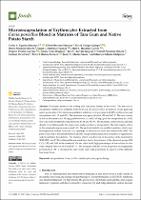| dc.contributor.author | Ligarda Samanez, Carlos A. | es_PE |
| dc.contributor.author | Moscoso Moscoso, Elibet | es_PE |
| dc.contributor.author | Choque Quispe, David | es_PE |
| dc.contributor.author | Palomino Rincón, Henry | es_PE |
| dc.contributor.author | Martínez Huamá, Edgar Luis | es_PE |
| dc.contributor.author | Huamán Carrión, Mary L. | es_PE |
| dc.contributor.author | Peralta Guevara, Diego E. | es_PE |
| dc.contributor.author | Aroni Huamán, Jimmy | es_PE |
| dc.contributor.author | Arévalo Quijano, José C. | es_PE |
| dc.contributor.author | Palomino Rincón, Wilbert | es_PE |
| dc.contributor.author | De la Cruz, German | es_PE |
| dc.contributor.author | Ramos Pacheco, Betsy S. | es_PE |
| dc.contributor.author | Muñoz Saenz, Jenny C. | es_PE |
| dc.contributor.author | Muñoz Melgarejo, Mauricio | es_PE |
| dc.date.accessioned | 2023-04-11T16:13:27Z | |
| dc.date.available | 2023-04-11T16:13:27Z | |
| dc.date.issued | 2022 | |
| dc.identifier.uri | https://hdl.handle.net/20.500.14168/763 | |
| dc.description.abstract | Ferropenic anemy is the leading iron deficiency disease in the world. The aim was to
encapsulate erythrocytes extracted from the blood of Cavia porcellus, in matrices of tara gum and
native potato starch. For microencapsulation, solutions were prepared with 20% erythrocytes; and
encapsulants at 5, 10, and 20%. The mixtures were spray-dried at 120 and 140 ◦C. The iron content
in the erythrocytes was 3.30 mg/g and between 2.32 and 2.05 mg/g for the encapsulates (p < 0.05).
The yield of the treatments varied between 47.84 and 58.73%. The moisture, water activity, and bulk
density were influenced by the temperature and proportion of encapsulants. The total organic carbon
in the atomized samples was around 14%. The particles had diverse reddish tonalities, which were
heterogeneous in their form and size; openings on their surface were also observed by SEM. The
particle size was at the nanometer level, and the zeta potential (ζ) indicated a tendency to agglomerate
and precipitation the solutions. The presence of iron was observed on the surface of the atomized by
SEM-EDX, and FTIR confirmed the encapsulation due to the presence of the chemical groups OH,
C-O, C-H, and N-H in the atomized. On the other hand, high percentages of iron release in vitro
were obtained between 88.45 and 94.71%. The treatment with the lowest proportion of encapsulants
performed at 140 ◦C obtained the best results and could potentially be used to fortify different
functional foods. | es_PE |
| dc.format | application/pdf | es_PE |
| dc.language.iso | eng | es_PE |
| dc.publisher | MDPI Journal List | es_PE |
| dc.rights | info:eu-repo/semantics/openAccess | es_PE |
| dc.rights.uri | | es_PE |
| dc.rights.uri | http://creativecommons.org/licenses/by-nc-nd/4.0/ | * |
| dc.subject | encapsulation; Cavia porcellus; erythrocytes; iron; spray drying | es_PE |
| dc.title | Microencapsulation of Erythrocytes Extracted from Cavia porcellus Blood in Matrices of Tara Gum and Native Potato Starch | es_PE |
| dc.type | info:eu-repo/semantics/article | es_PE |
| dc.type.version | info:eu-repo/semantics/publishedVersion | es_PE |
| dc.publisher.country | CH | es_PE |
| dc.subject.ocde | http://purl.org/pe-repo/ocde/ford#2.11.01 | es_PE |
| dc.identifier.doi | https://doi.org/10.3390/foods11142107 | es_PE |


